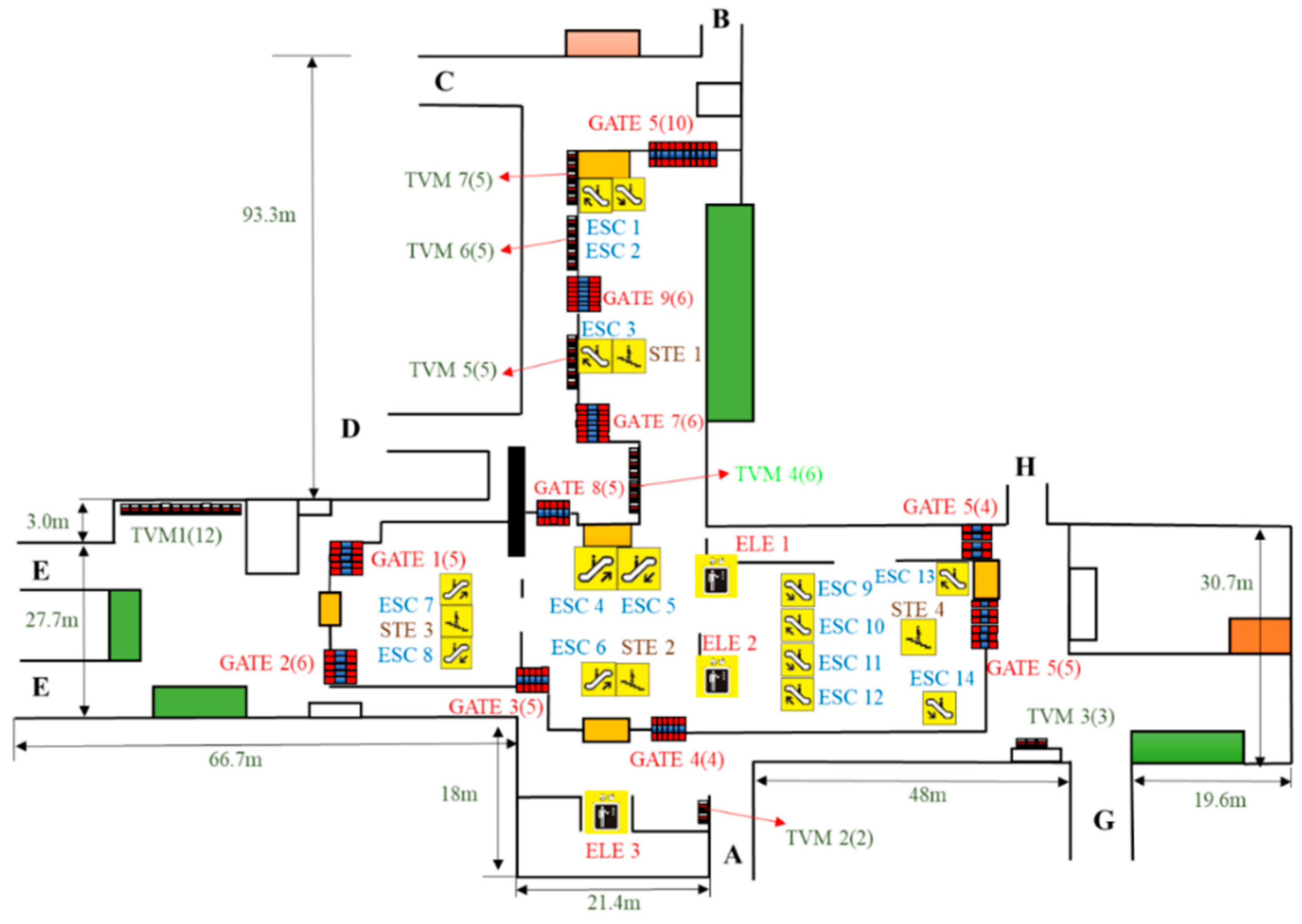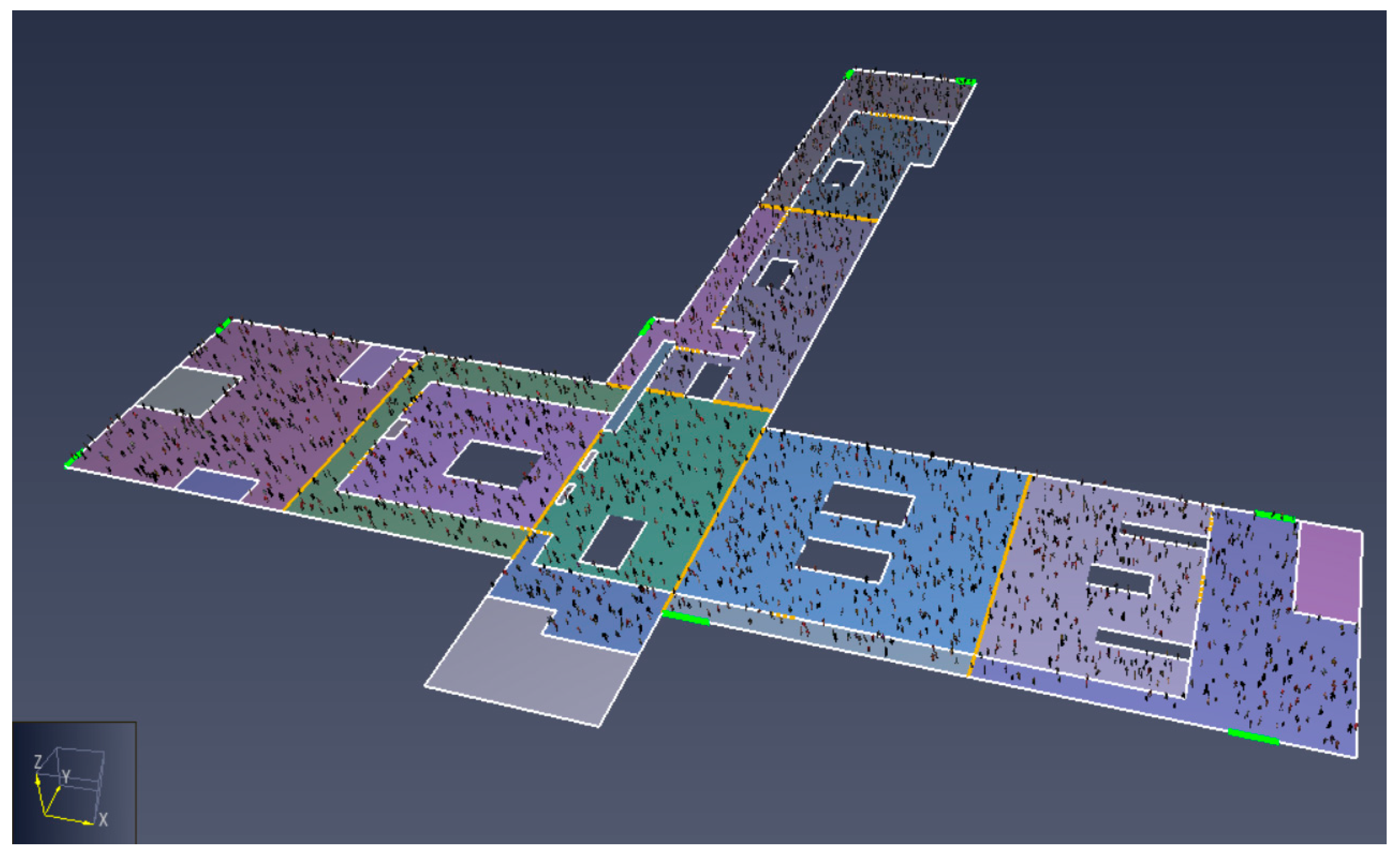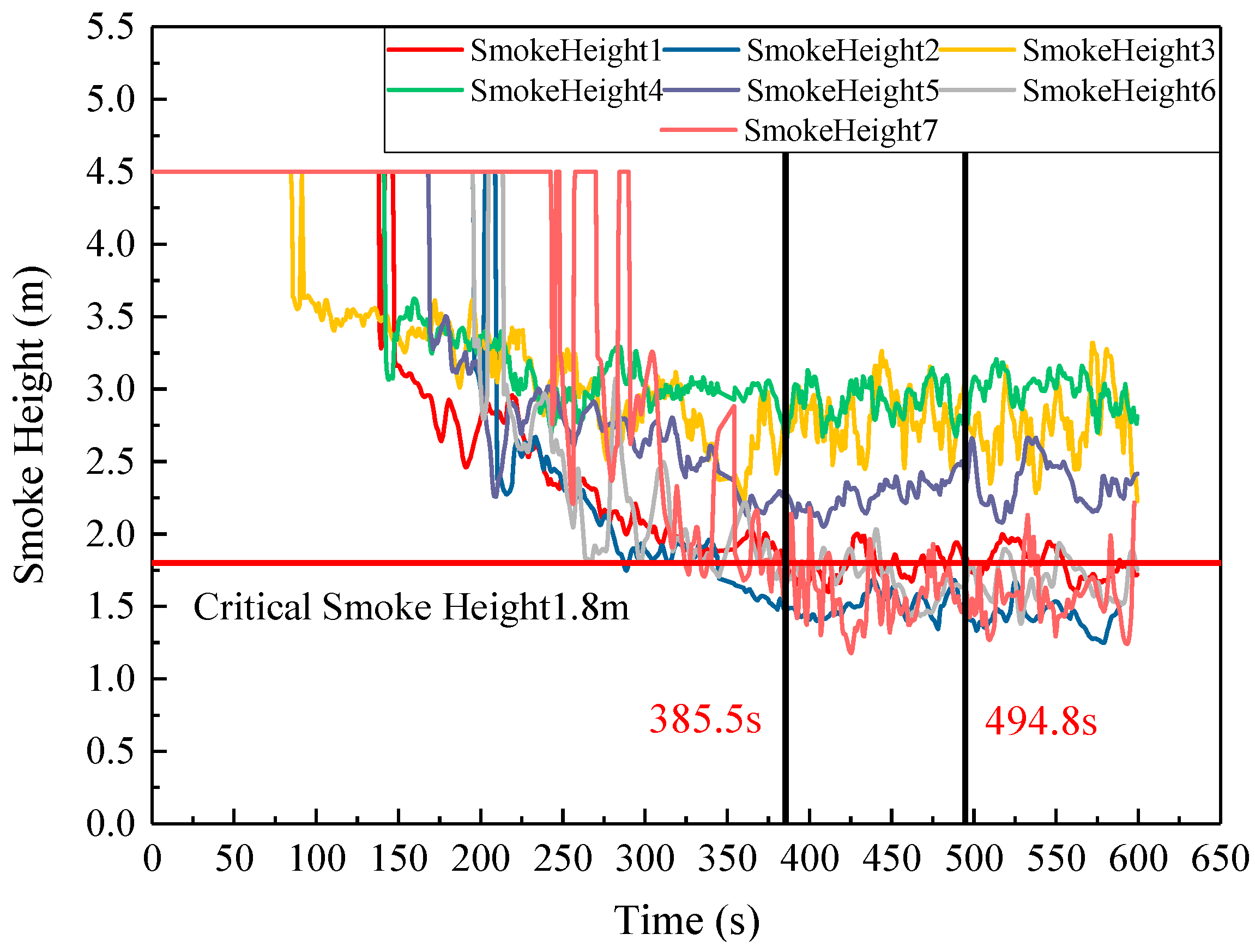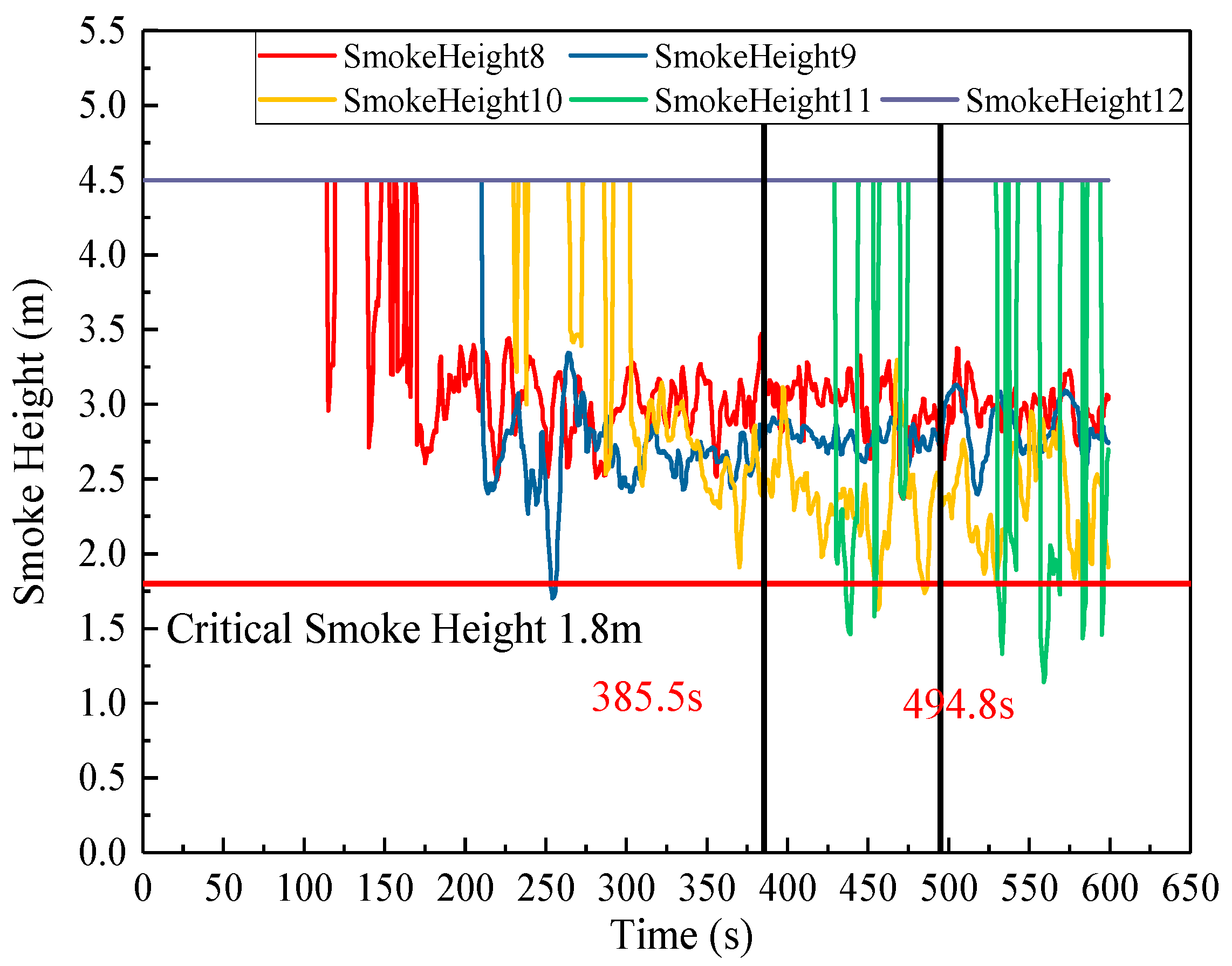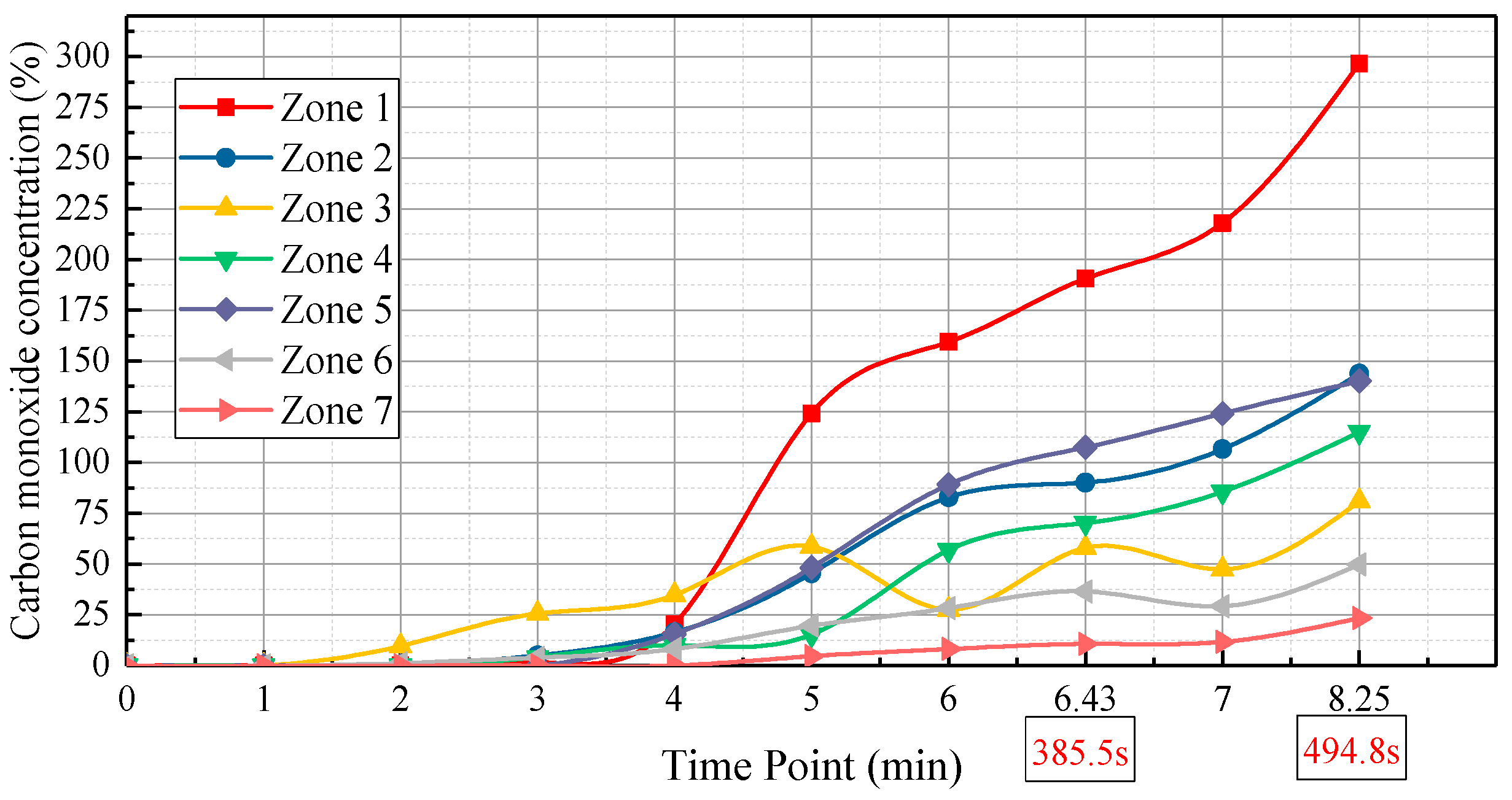2.3. Factors Affecting Safety
In the event of a fire in an underground metro station, safe evacuation requires various harmful factors to be taken into account, notably the temperature, smoke height, concentration of carbon monoxide (CO), and toxic gases at the fire site, generally, and along the evacuation routes in particular. Research has shown that these factors seriously affect the speed of evacuation [
12,
13], and their potential impact on the people involved in an evacuation requires in-depth analysis. The present study analyzes the time-related influence of smoke height, high temperature, CO, and low oxygen on the human body, and then uses the results to establish a comprehensive fire evacuation safety judgment method.
(1) Smoke height. When a fire breaks out in a relatively closed space, because the hot smoke is less dense than air, the smoke first gathers at the top of the space and then gradually descends. This is called the ceiling effect [
14]. The smoke produced by a fire has a high temperature, and people at the fire site who come into direct contact with the smoke may suffer high-temperature burns, obstructed vision, eye irritation, and other negative consequences. Therefore, only when the smoke remains above a critical safe height is the crowd at the scene of the fire likely to be able to evacuate safely [
15,
16] (National Fire Protection Association, 2017; International Code Council, 2017). For safe evacuation, the Life Safety Code (NFPA 101) consensus standard stipulates a smoke height greater than 1.8 m. Hence, the critical safe smoke height for the present study is 1.8 m.
The time necessary for the smoke to drop to a critical safe height is referred to as ASET determined by smoke. When ASET determined by smoke is less than RSET, the evacuation can be completed safely without the negative effects of smoke.
(2) Heat. Humans can tolerate a few minutes of ambient radiated heat less than 2.5 kW/m
2. At higher levels of radiated heat, skin burns appear in a short time [
17]. According to the SFPE Guide to Human Behavior in Fire [
18], when the human body is exposed to fire in a moderately humid environment, the time required for heat radiation to cause severe burns or incapacitation is calculated as in Equation (2).
where
T is the ambient temperature (°C).
The following three-step method of judging the influence of temperature on evacuation safety is therefore proposed.
Step 1: Determine the value of RSET.
Step 2: By fire test or fire simulation, obtain the average temperature in different zones 0–1 min, 1–2 min, …, (RSET − 1) − RSET, i.e., Taverage(0–1 min), Taverage(1–2),…, Taverage((RSET−1)−RSET). The length of time can be adjusted in practice.
Step 3: Put Taverage(0–1 min), Taverage(1–2),…, Taverage((RSET−1)−RSET) into Equation (2) to obtain the time to severe burns or incapacitations, i.e., tinjure(0–1), tinjure(1–2),…, tinjure((RSET−1)−RSET).
If all values are less than 1 min, the evacuation can be completed safely without the negative effects of temperature.
(3) Carbon monoxide. CO produced by the insufficient combustion of carbon-containing substances is very common in fires and is one of the most harmful poisonous gases to evacuees [
19]. CO binds with hemoglobin in the blood to form carboxyhemoglobin (COHb), which reduces the binding of hemoglobin with oxygen and leads to insufficient oxygen in the blood. Lack of oxygen in the blood is detrimental to oxygen supply to brain tissue and can lead to coma, confusion, loss of consciousness, and even death [
20]. Studies on humans and animals have established 30% as the safety-critical concentration of COHb in human blood [
21,
22,
23,
24,
25].
According to the SFPE Guide to Human Behavior in Fire, for people exposed to air at a constant concentration of CO, the concentration of COHb in the blood can be calculated using what is known as the Stewart equation:
where
denotes the accumulated concentration of COHb in the blood,
is the concentration of CO in the environment, and
is the respiratory rate (L/min). For humans at rest or asleep,
= 8.5; when walking,
= 25; during strenuous exercises, such as jogging or climbing stairs,
= 50.
denotes the duration of exposure (in minutes).
Equation (3) applies when the concentration of CO in the air remains constant. At a fire site, however, the concentration of CO tends to change over time. Thus, the following four-step modification to Equation (3) is required to form a CO safety judgment:
Step 1: Determine the value of RSET.
Step 2: Obtain the CO concentration curve during 0 − RSET through a fire test or fire simulation.
Step 3: Obtain the change function of CO concentration during 0 − RSET, through data fitting.
Step 4: Put
into Equation (3) and then integrate in time to obtain the accumulated concentration of COHb in blood:
If is less than 30%, the evacuation can be completed safely without the negative effects of CO.
(4) Low oxygen. Low levels of oxygen at the fire site can cause a lack of oxygen in the human brain and may affect people’s ability to evacuate. When oxygen content drops below 10%, thinking and judgment are significantly affected; when it drops below 6%, there is a possibility of suffocation and death. Ref. [
26] proposed the use of Equation (5) to calculate the time to unconsciousness or incapacitation in people exposed to constant hypoxia [
27]:
where
denotes the ambient oxygen content.
Equation (5) applies when the oxygen content in the environment is constantly low. At a fire site, however, the oxygen content tends to change over time. Thus, the following three-step modification to Equation (5) is required to form an oxygen safety judgment:
Step 1: Determine the value of RSET.
Step 2: Obtain the average oxygen content in different zones at 0–1 min, 1–2 min,…, (RSET − 1) − RSET, i.e., %O2average(0–1 min), %O2average(1–2),…, %O2average((RSET−1)−RSET) through a fire test or fire simulation. The length of time can be adjusted in practice.
Step 3: Put %O2average(0–1 min), %O2average(1–2),…, %O2average((RSET−1)−RSET) into Equation (5) to obtain the time to severe burns or incapacitation, i.e., , …, . If the time values are all less than 1 min, the evacuation can be completed safely without the negative effects of low oxygen.
2.4. Safety Judgment with Harmful Factors Integrated
Although each harmful factor is assessed independently, the final safety judgment considers the integrated outcome of all factors, ensuring that evacuation is only deemed safe when all criteria are simultaneously satisfied.
Table 1 sets out the safety judgment method for fire evacuation derived from the considerations above. Smoke height, heat, CO, and low oxygen must be taken into account; only when all four criteria are satisfied can an evacuation be completed safely.
A review of the literature indicates that existing methods assess individual factors affecting evacuation safety. Although physical models integrating fire hazards exist, there remains a lack of dynamic, simulation-based evacuation assessment models that holistically evaluate smoke height, temperature, CO, and oxygen depletion in complex underground spaces. This article addresses this gap by developing a unified safety assessment approach that considers smoke height, heat, CO levels, and oxygen depletion, thereby offering a more holistic evaluation of evacuation safety in underground metro stations.
Following the safety assessment method proposed, a case study is presented to validate the proposed approach in a practical context. The case study involves an underground metro station in Guangzhou, China, which serves as a real-world testbed for applying and refining the integrated safety evaluation model. This case study is crucial as it provides empirical data to assess the effectiveness of the proposed evacuation strategies and safety criteria in an actual fire scenario. By analyzing specific factors such as smoke behavior, temperature variations, CO concentrations, and oxygen levels within this operational environment, the case study demonstrates the applicability and reliability of the theoretical model. It also highlights any potential limitations and areas for further refinement, ensuring that the safety assessment method is both practical and robust for real-world applications.



